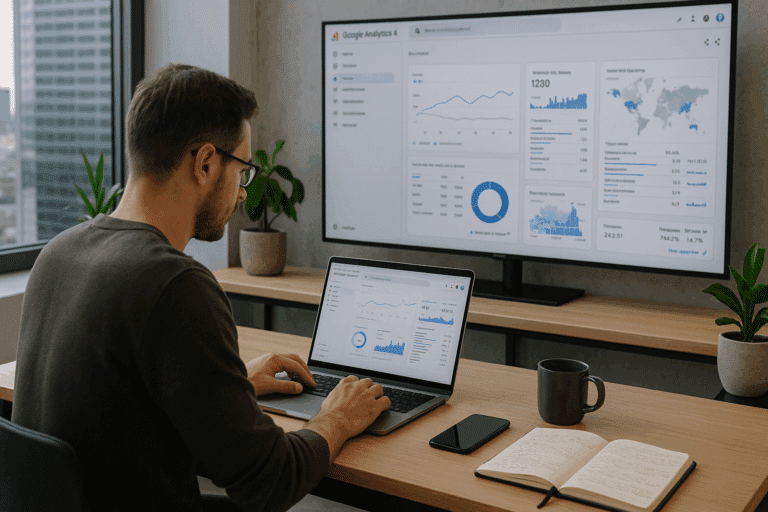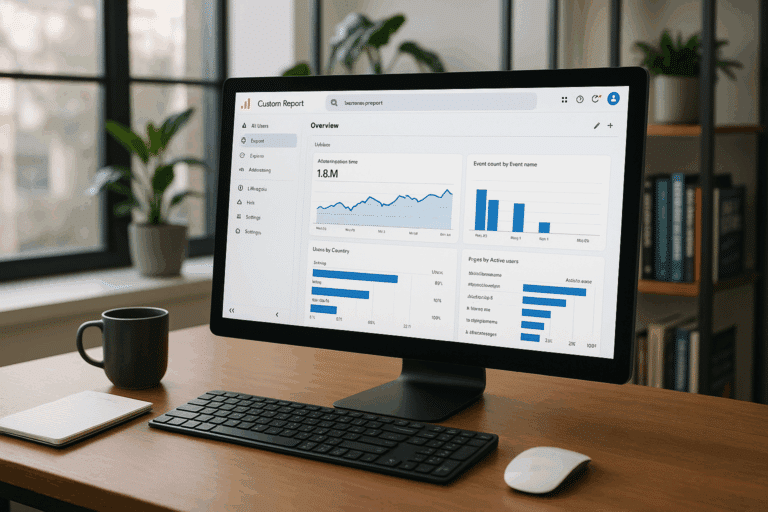But fear not! 👨💻 As your trusted guide, I am here to illuminate the path forward, turning complexity into comprehensibility.
Today, we’re about to unravel the secrets of GA4, with a laser focus on mastering acquisition reports for maximum marketing success. So, if you’re a marketer looking to level up your data analysis skills or a tech enthusiast keen on making the most out of GA4, you’re in the right place.
Why the Focus on Acquisition Reports?
As the age-old saying goes, “You can’t manage what you can’t measure”. In the digital marketing realm, this couldn’t be more true, especially when it comes to acquisition metrics. 🎯
Acquisition reports, as a critical part of GA4, allow us to understand the ‘Who’, ‘What’, ‘Where’, and ‘How’ of our audience engagement. They provide insights into the sources driving traffic to our websites, the effectiveness of our marketing efforts, and the behavior of our users, equipping us with the information we need to make strategic decisions and optimize marketing outcomes.
Thus, by mastering GA4 acquisition reports, we are essentially unlocking the door to a treasure trove of actionable data, driving us towards our ultimate goal – maximum marketing success.
What to Expect?
Within the confines of this comprehensive guide, we will dissect GA4’s acquisition reports, unraveling their structure, key components, and usage. We will commence by understanding the basic terminologies and principles associated with GA4 acquisition reports. Following this, we will delve into the specificities of various acquisition reports and how to interpret them.
From traffic acquisition to user behavior and conversion patterns, we will explore every corner of GA4 acquisition reports, providing practical tips and strategies to effectively analyze and leverage this data. All the while, we will keep an eye on the broader picture, ensuring that our understanding of these reports is firmly rooted in the overall context of marketing success.
Who Is This Guide For?
This guide is tailored to cater to both novices and seasoned professionals. Whether you’re a startup owner trying to get a handle on your website’s performance, a digital marketer looking to optimize your campaign’s ROI, or a data analyst keen on understanding GA4’s offerings, this guide is your handy companion. 🚀
So, buckle up as we embark on this data-driven journey to unlock the secrets of GA4’s acquisition reports. And remember, every piece of data, every metric, and every report is a piece of the puzzle, bringing us one step closer to our goal of maximum marketing success. So let’s dive right in, shall we?
Unveiling the Enigma of GA4: How to Harness Acquisition Reports for Unparalleled Marketing Success
Google Analytics 4 (GA4) has been an essential part of the marketing toolkit since its inception, providing marketers with a comprehensive overview of their audience’s behaviors and preferences. However, its full potential is often not fully exploited, particularly when it comes to Acquisition Reports. Are you ready to unlock the secrets of GA4? Let’s dive in!
Acquisition Reports in GA4 are a treasure trove of data, offering insights into where your users are coming from and how they interact with your content. They allow you to identify the marketing channels that are driving the most traffic and engagement, enabling you to refine your strategies and maximize your ROI. But to truly harness the power of Acquisition Reports, you need to understand how to navigate through the data and interpret it correctly.
This comprehensive guide will walk you through the intricacies of GA4 Acquisition Reports, showing you how to access them, interpret the data, and apply your findings for maximum marketing success. As an added bonus, we’ll show you how to use the data from these reports to optimize your conversion funnel, boost your marketing efforts, and enhance your user experience. So, let’s get started!
Demystifying the Acquisition Reports: Breaking Down the Key Components
Before we delve deeper into how to utilize Acquisition Reports, it’s crucial to understand the key components and what they mean. These reports are broken down into different sections, each offering unique insights into your audience acquisition. Here’s a quick overview:
| Component | Description |
| Users | Number of unique users who have engaged with your content. |
| Sessions | Number of sessions initiated by your users. |
| Bounce rate | Percentage of single-page sessions where the user left your site without interacting further. |
| Session duration | Average length of a session. |
| New users | Number of first-time users during a given period. |
By understanding these components, you can gain valuable insights into your audience’s behaviors and preferences. For a more detailed explanation, check out the video ‘Understanding Google Analytics 4 Acquisition Reports’ by Measureschool on YouTube.
Accessing Acquisition Reports in GA4
Now that we’ve broken down the key components, let’s move on to how you can access Acquisition Reports in GA4. The process is straightforward and can be accomplished in just a few steps.
- Sign in to your Google Analytics account.
- Select the property you want to analyze from the drop-down menu.
- Click on ‘Acquisition’ in the left-hand menu.
- Select ‘User Acquisition’ to view the report.
Once you’ve accessed the report, you can choose from various metrics to customize your data view and focus on the aspects that are most relevant to your business. For a visual guide on accessing and navigating Acquisition Reports in GA4, watch ‘GA4 (Google Analytics 4) Acquisition Reports – Complete Guide’ by Analytics Mania on YouTube.
Interpreting the Data: How to Derive Meaningful Insights from Your Acquisition Reports
Now comes the most critical part: interpreting the data. With so much information at your disposal, it’s easy to feel overwhelmed. But don’t worry! We’re here to help you navigate through the data.
The key to successful data interpretation lies in understanding what each metric represents and how it applies to your business. For instance, a high bounce rate may suggest that your landing page isn’t engaging enough, or that users are finding it difficult to navigate your site. Similarly, a low number of new users may indicate that your marketing efforts aren’t reaching a broad enough audience.
When interpreting the data, it’s also important to consider the context. For instance, a sudden spike in traffic could be due to a successful marketing campaign, or it could be a sign of bot activity. To distinguish between these scenarios, you can use other metrics such as session duration and pages per session. If these metrics are unusually low, it may suggest that the traffic is not genuine.
Turning Insights into Action: How to Leverage Your Acquisition Reports for Maximum Marketing Success
Acquisition Reports aren’t just about collecting data; they’re about using that data to drive your marketing strategies. By understanding where your users are coming from and how they’re interacting with your content, you can tailor your marketing efforts to meet their needs and preferences.
For instance, if you find that a particular marketing channel is driving a lot of traffic but has a high bounce rate, it might be worth investigating why users are leaving your site. Is the content not relevant to them? Is the user experience subpar? Answering these questions can help you refine your strategies and improve user engagement.
Similarly, if a certain demographic is underrepresented in your user base, you might want to consider targeting your marketing efforts towards this group. By aligning your strategies with your audience’s behaviors and preferences, you can maximize your marketing success.
For more practical tips on how to use GA4 Acquisition Reports to enhance your marketing efforts, check out the video ‘Google Analytics 4 (GA4) – Complete Beginner’s Guide’ by Surfside PPC on YouTube.
Optimizing Your Conversion Funnel with GA4 Acquisition Reports
Finally, GA4 Acquisition Reports can also be used to optimize your conversion funnel. By identifying where users are dropping off, you can pinpoint problem areas and work towards improving them.
For instance, if you notice that many users are leaving after viewing a product page, it might suggest that the page is not convincing enough, or that the checkout process is too complicated. By addressing these issues, you can improve your conversion rate and boost your overall marketing success.
Remember, data is only as valuable as the action it drives. So, use your Acquisition Reports not just to gather information, but to shape your marketing strategies and enhance your user experience. The key to mastering GA4 lies in understanding its capabilities and using them to your advantage. So, go ahead and unlock the secrets of GA4 – your marketing success awaits!

Conclusion
In conclusion, as we have navigated the deep and multifaceted realm of software engineering and information technology, it is evident that these fields are complex yet fascinating. The comprehension and application of these areas can seem daunting but with the right knowledge, a diligent mindset, and consistent practice, one can indeed master them. Let’s take a moment to recap the key points we’ve discussed.
We began with the basics of software engineering, emphasizing its importance in the creation and maintenance of software systems. This included a thorough understanding of the software development life cycle (SDLC), along with the role of different software engineering methodologies, such as Agile, Scrum, and DevOps. We dove into the essential principles of coding, algorithms, and data structures, and shed light on the significance of quality assurance and testing in the product development cycle.
Next, we moved on to the realm of information technology, elaborating on its role in managing and processing information. We explored the importance of database management systems, network architecture, and cybersecurity in the smooth functioning of businesses today. We also discussed the latest trends in these fields, including artificial intelligence, machine learning, cloud computing, and blockchain technology.
We also talked about the importance of soft skills, such as problem-solving, communication, teamwork, and project management. These skills, coupled with technical knowledge, make a well-rounded professional in these fields.
Understanding these concepts can open doors to a plethora of opportunities in the IT and software engineering industry. From developing cutting-edge software and mobile applications to designing robust IT infrastructure and securing them from cyber threats, the possibilities are truly endless.
These areas are continually evolving, with new tools, technologies, and methodologies emerging regularly. Therefore, it is essential to stay updated and keep learning. Consider exploring reputable resources such as TechRepublic or Stack Overflow for the latest updates and discussions in these fields.
Remember, the journey of mastering these subjects can be challenging, but also rewarding. Take one step at a time, keep the curiosity alive, and the world of software engineering and IT is yours to conquer.
I hope you found this article enlightening and helpful. Feel free to share it with your colleagues, friends, or anyone who might find it useful. If you have any questions or thoughts to share, don’t hesitate to leave a comment below. I’d be more than happy to engage in a conversation with you. Let’s continue our journey of learning together. Happy coding! 😊👨💻🚀
References:
TechRepublic
Stack Overflow
[tags]: #softwareEngineering #InformationTechnology #coding #cybersecurity #cloudComputing #blockchain #Agile #Scrum #DevOps #machineLearning #AI



